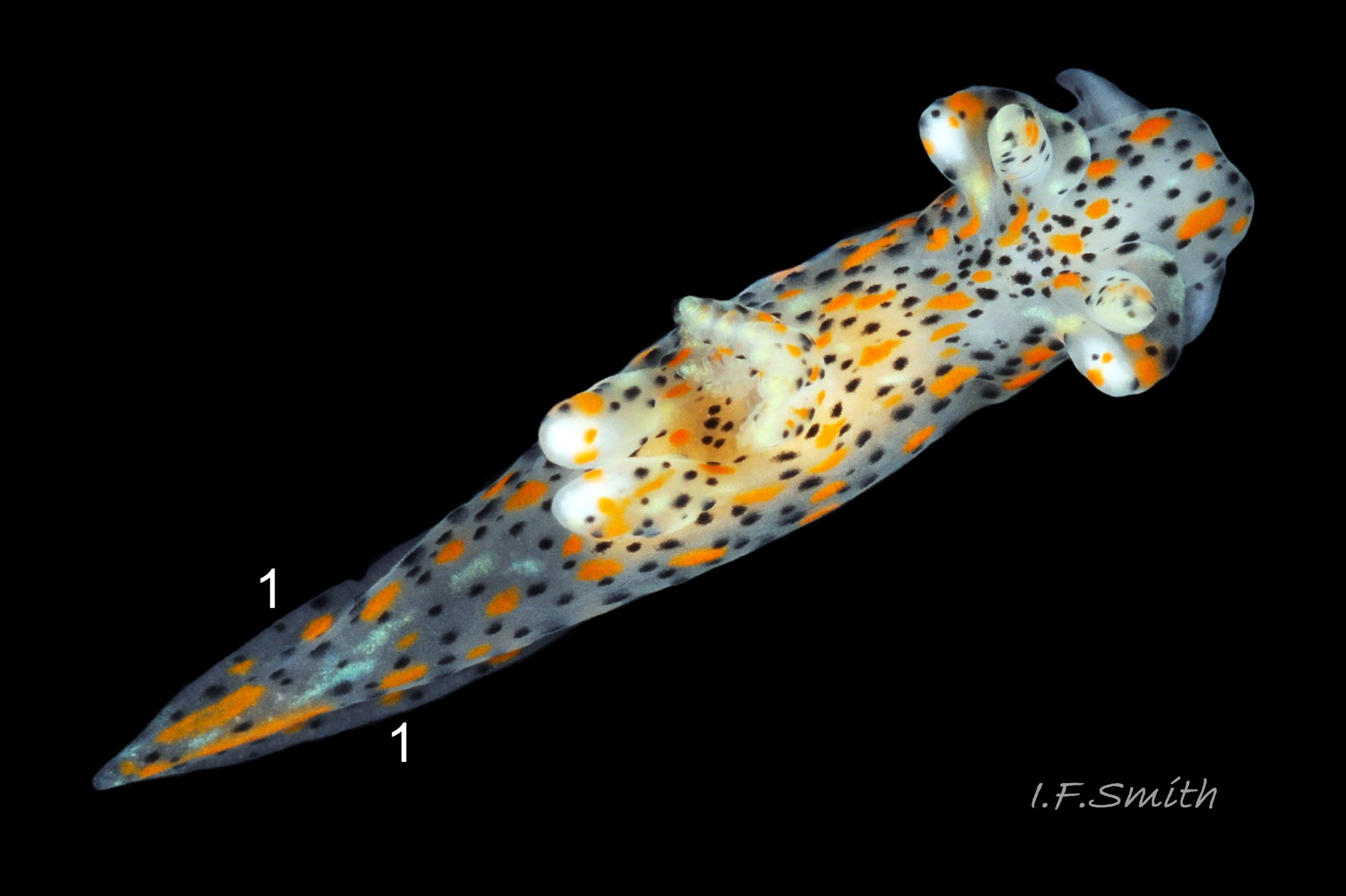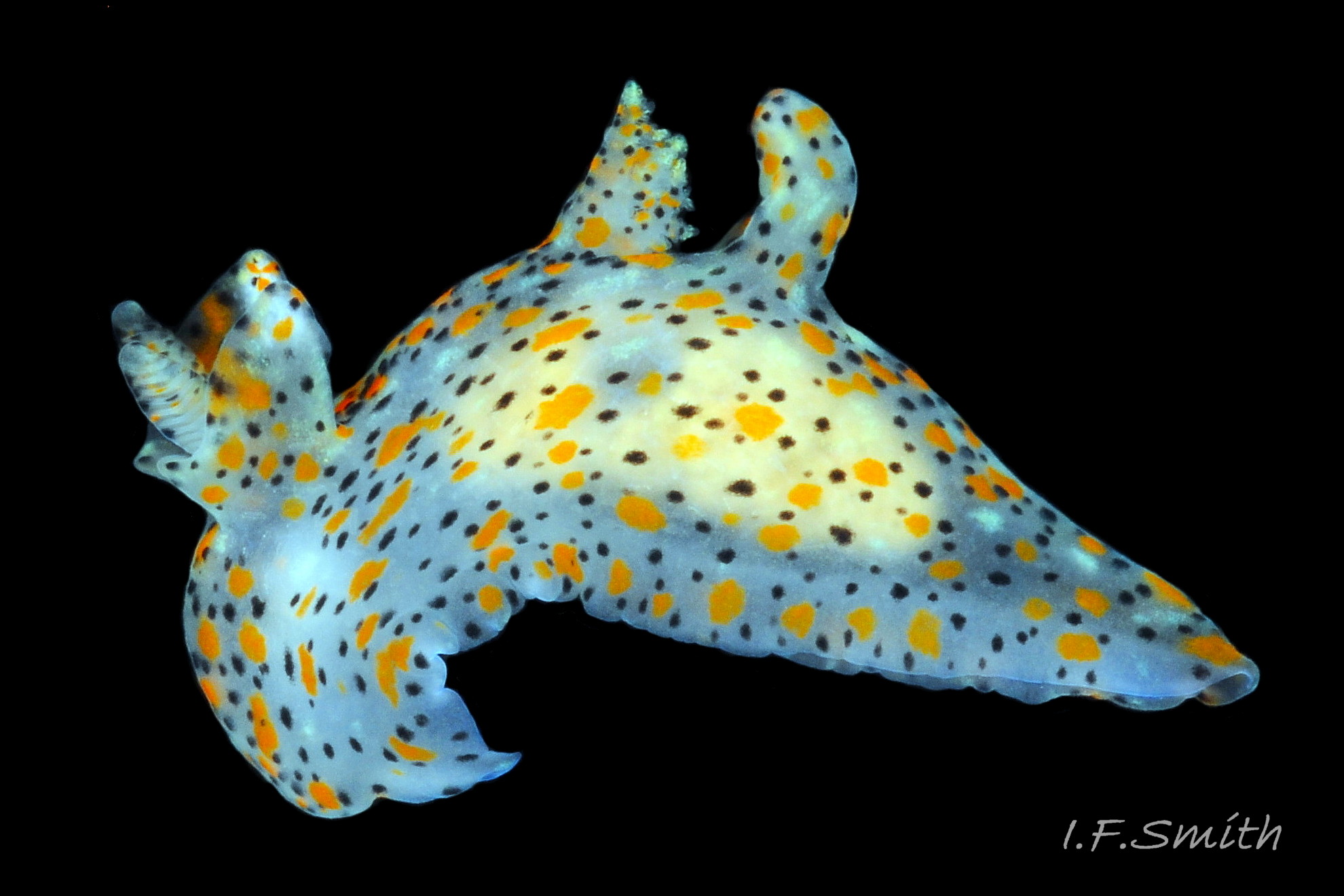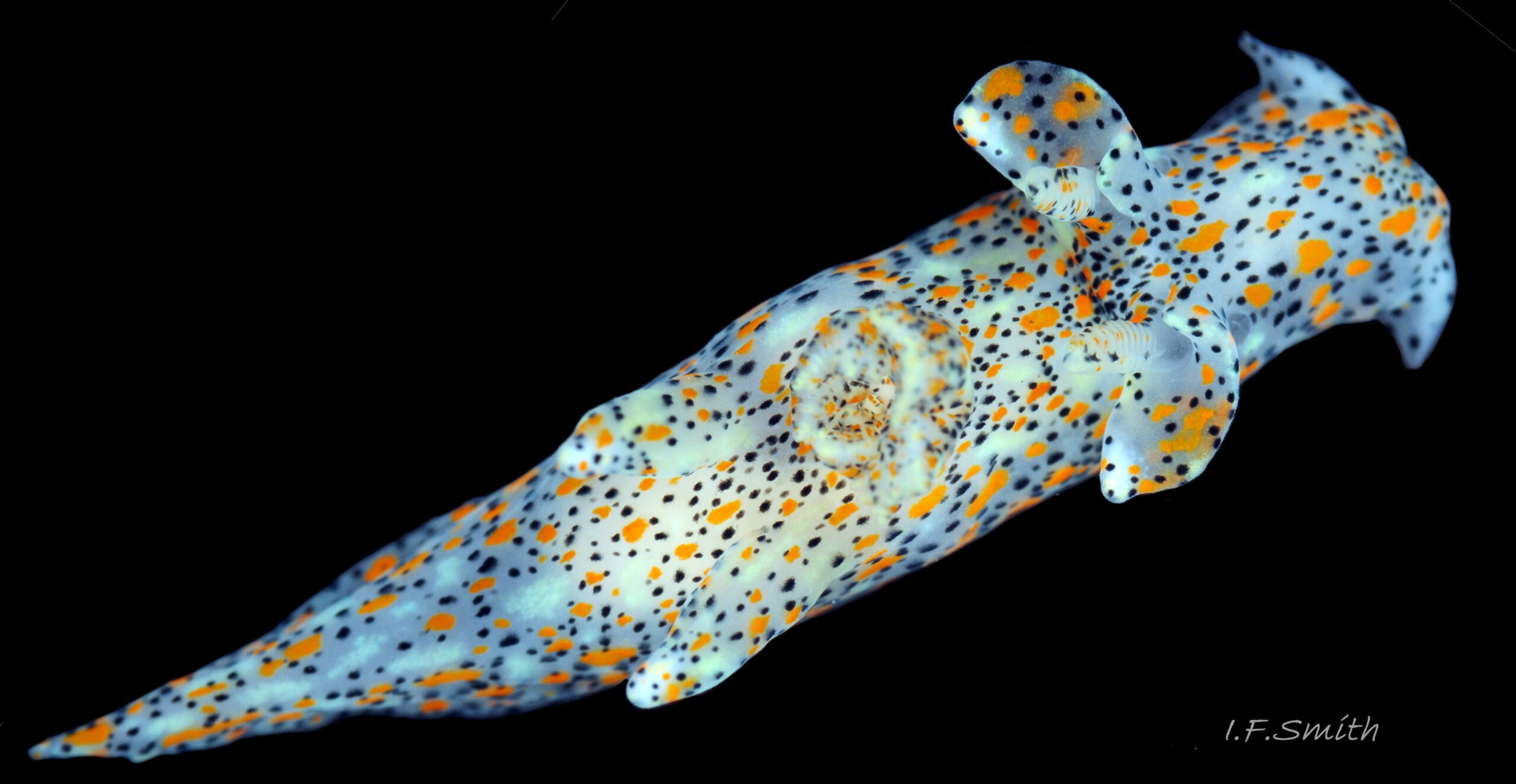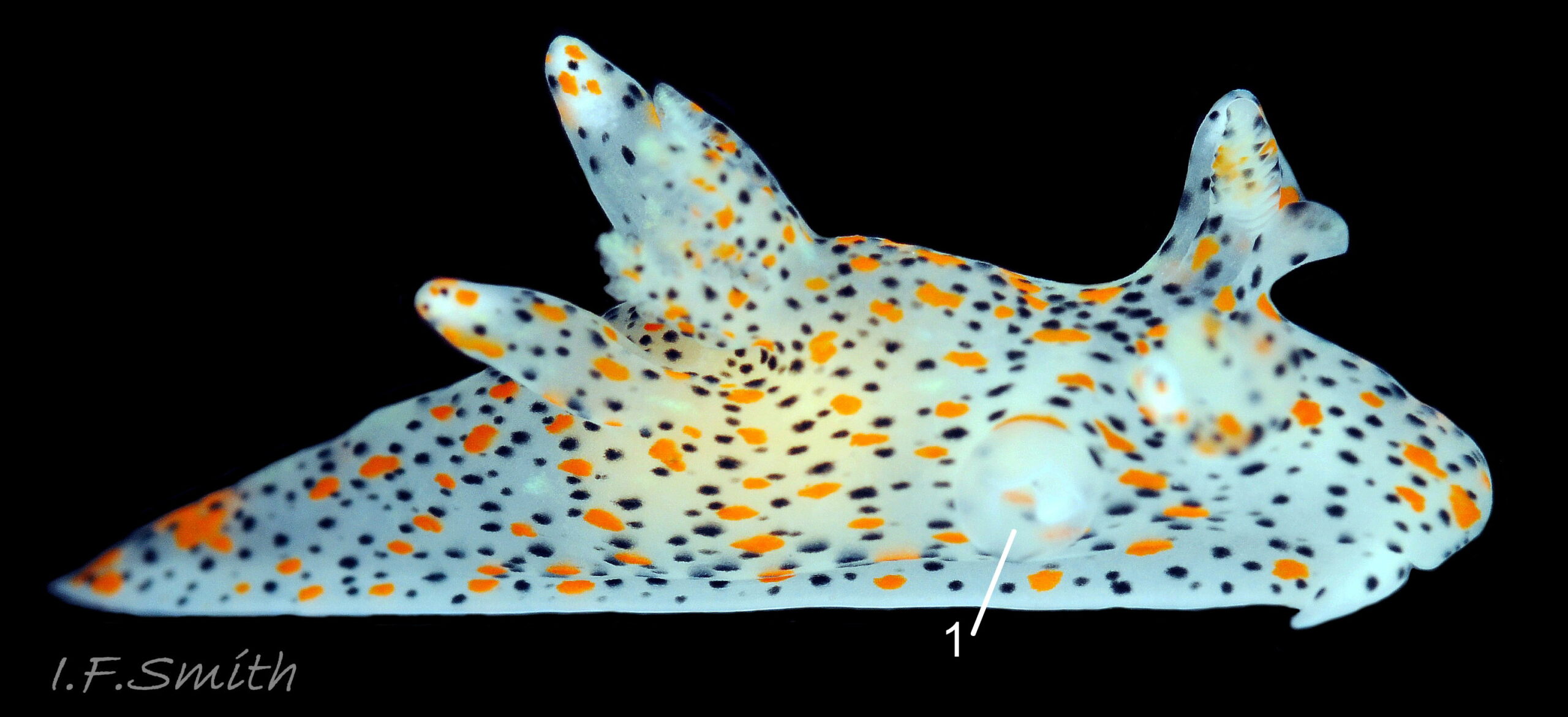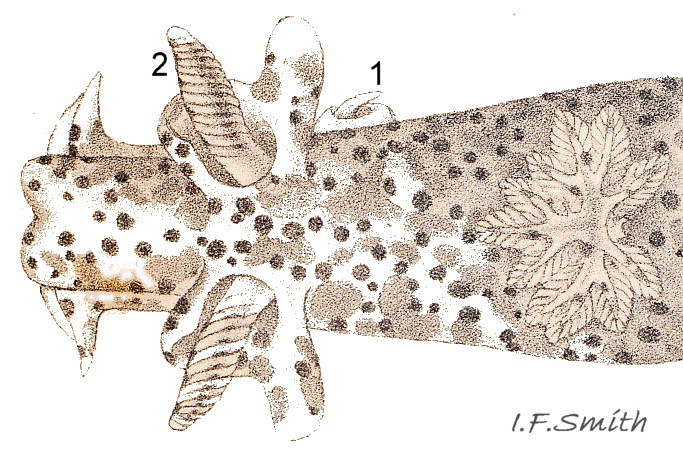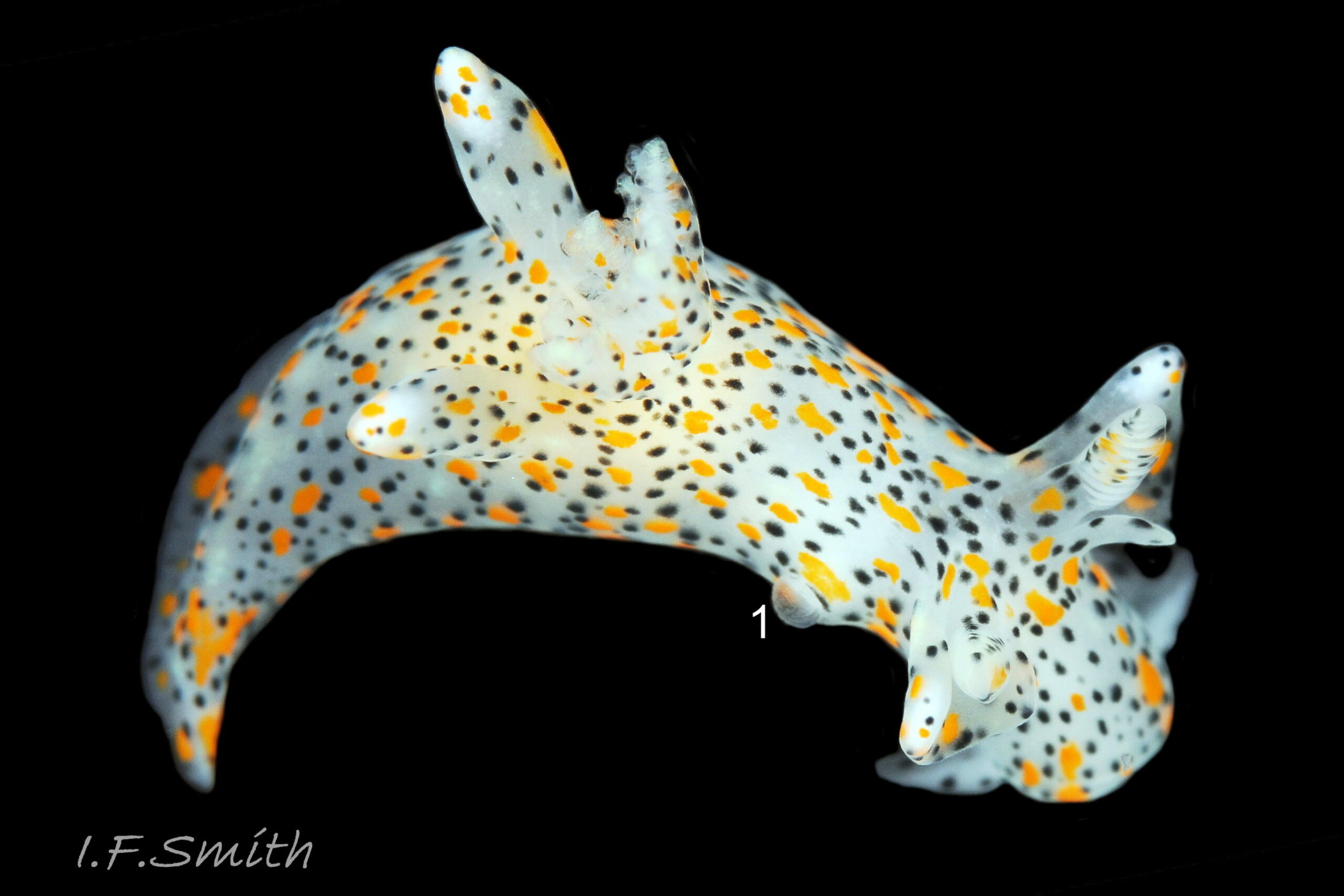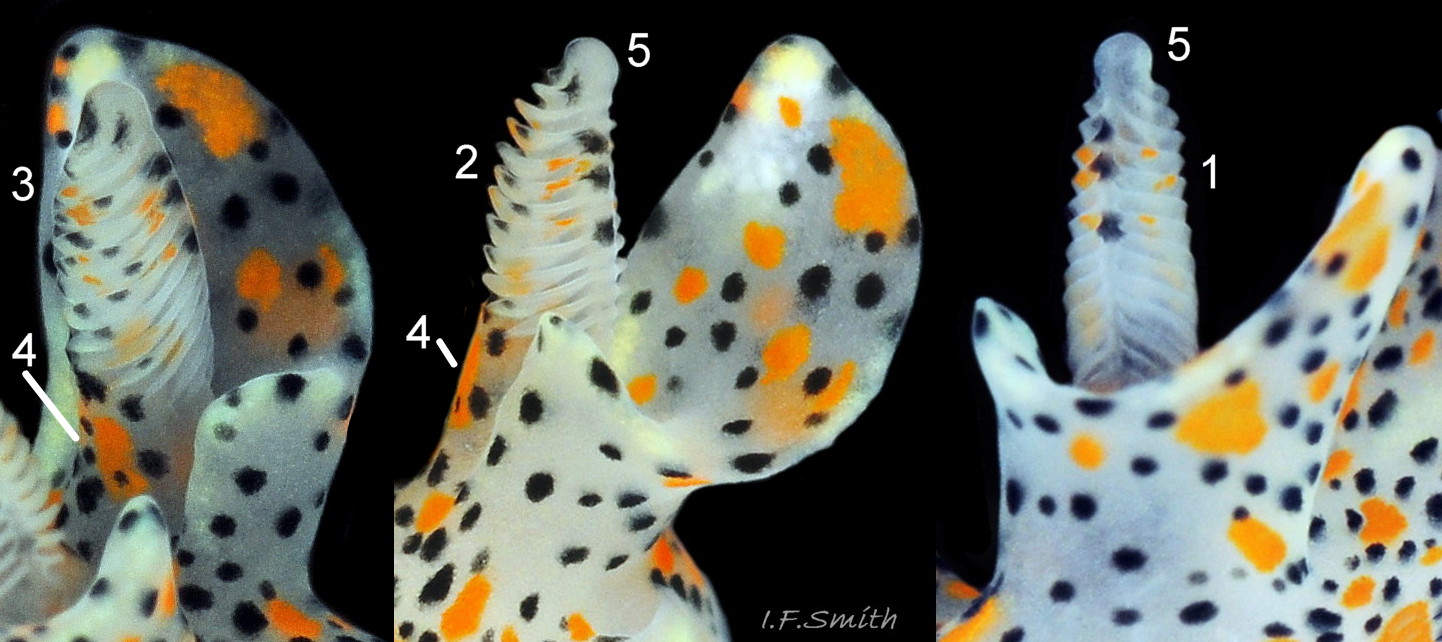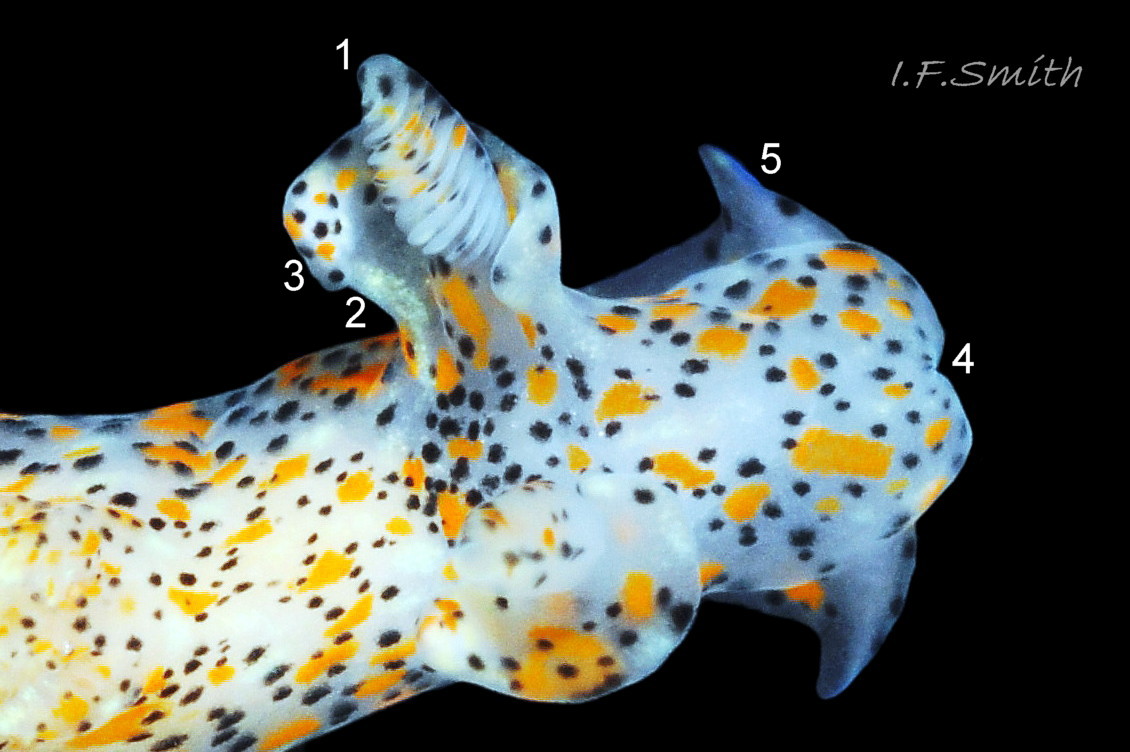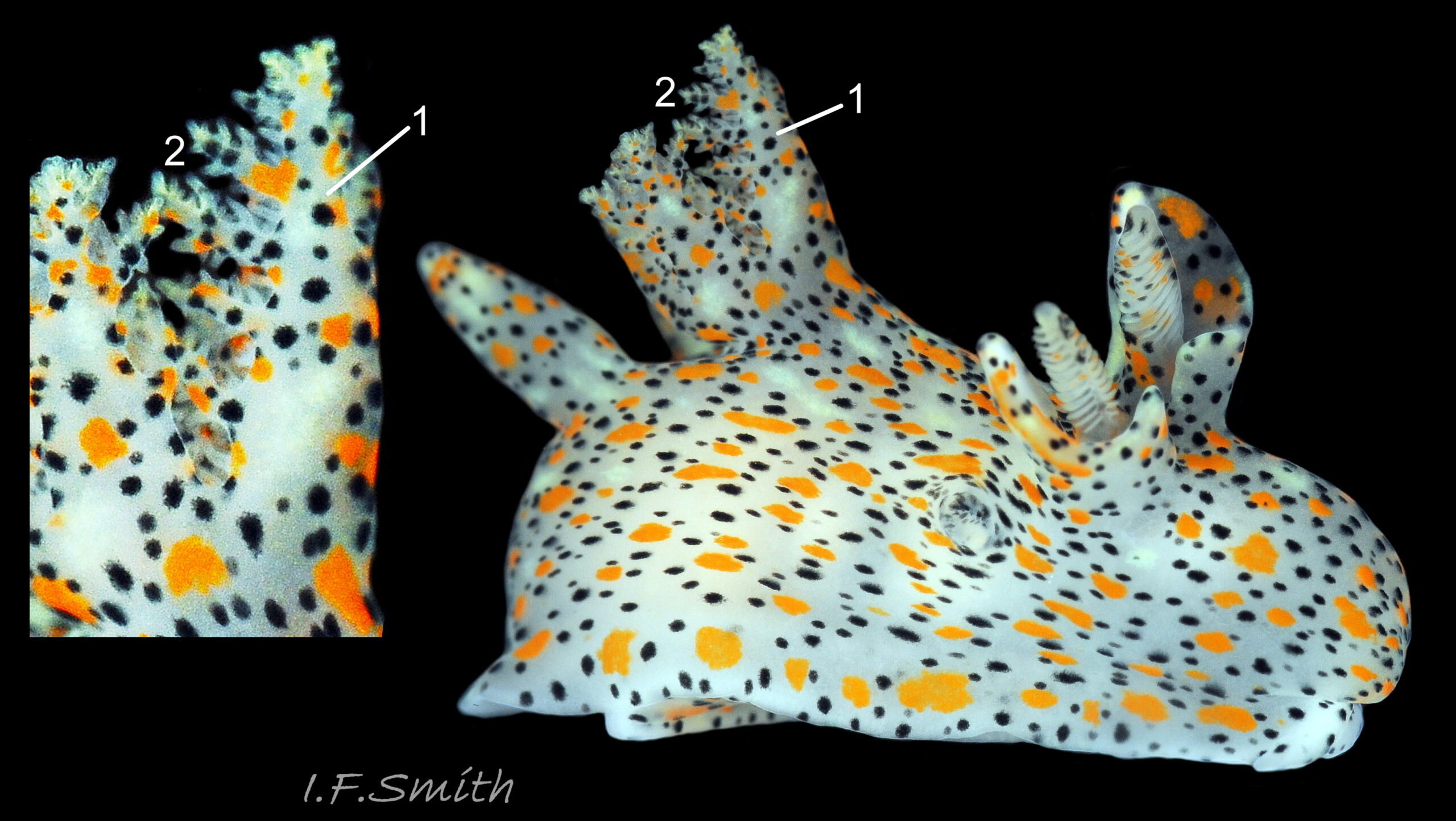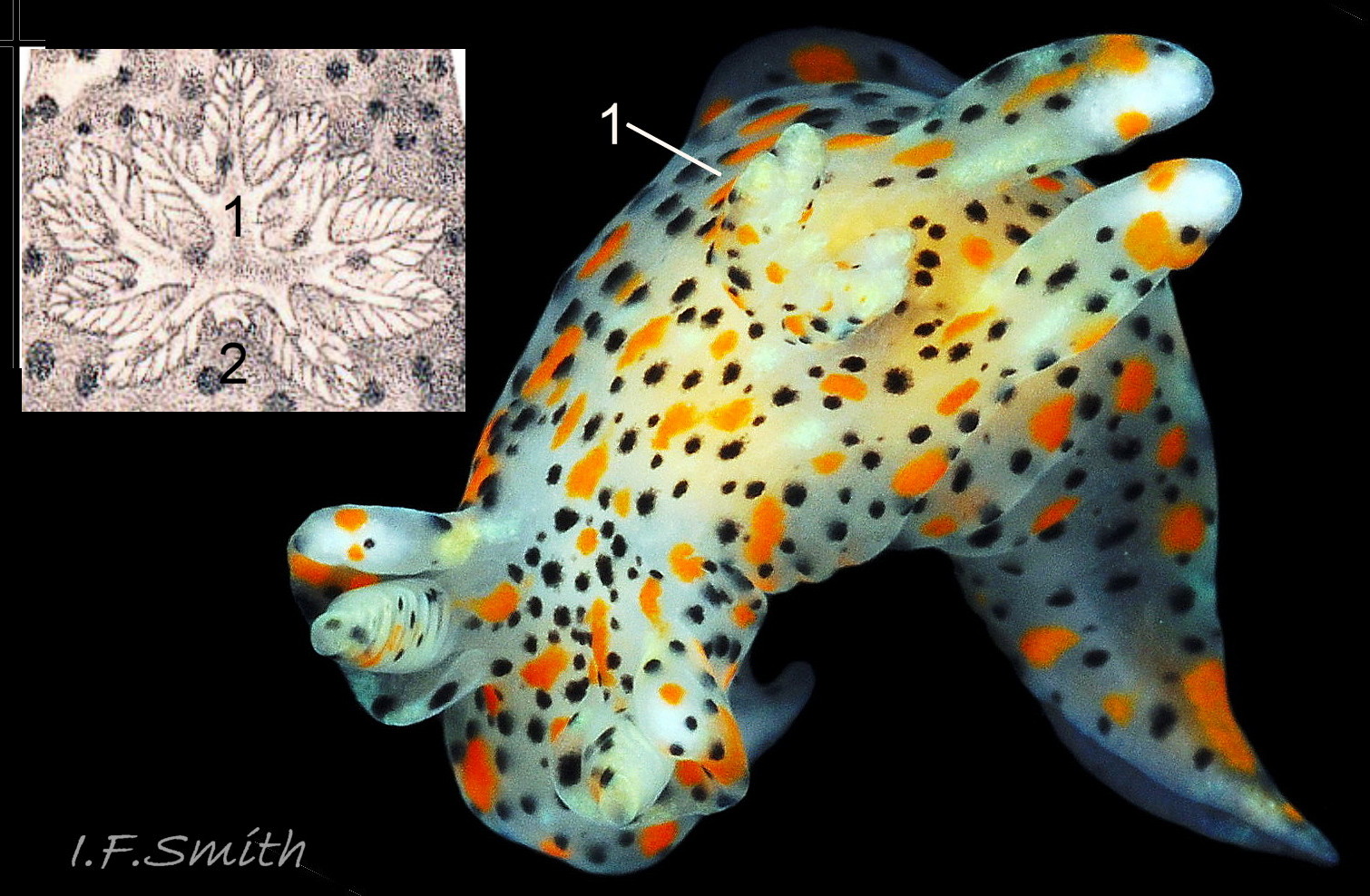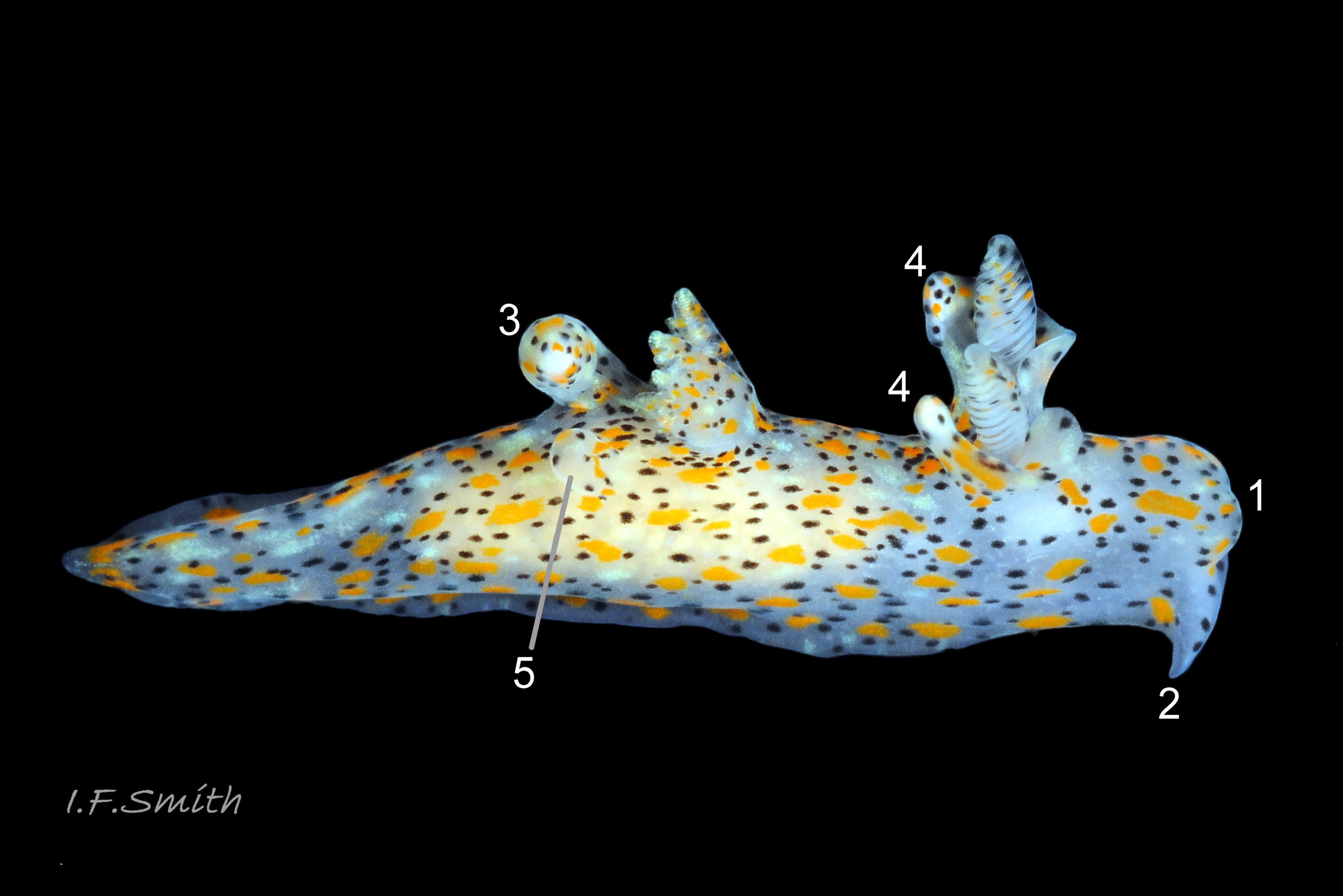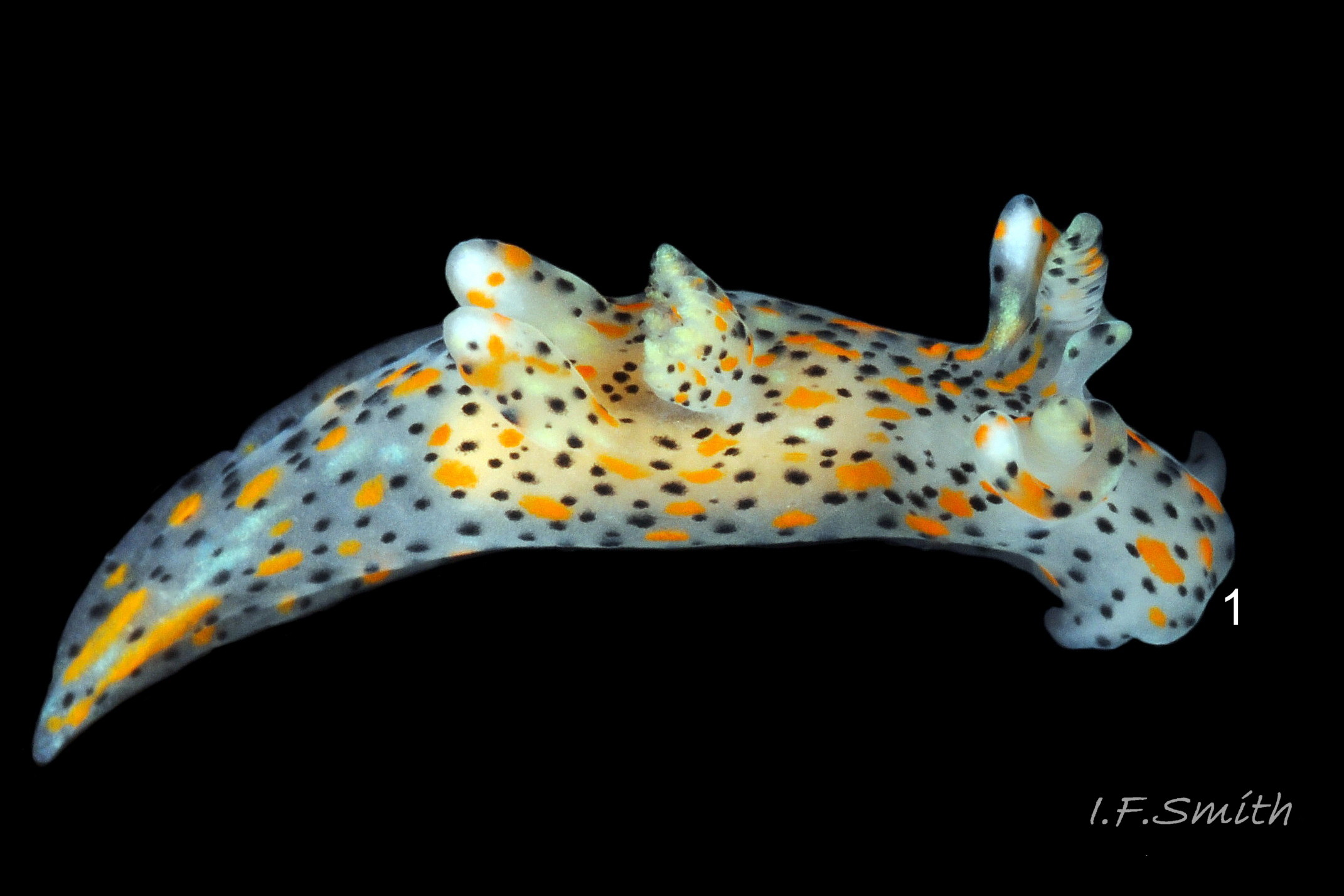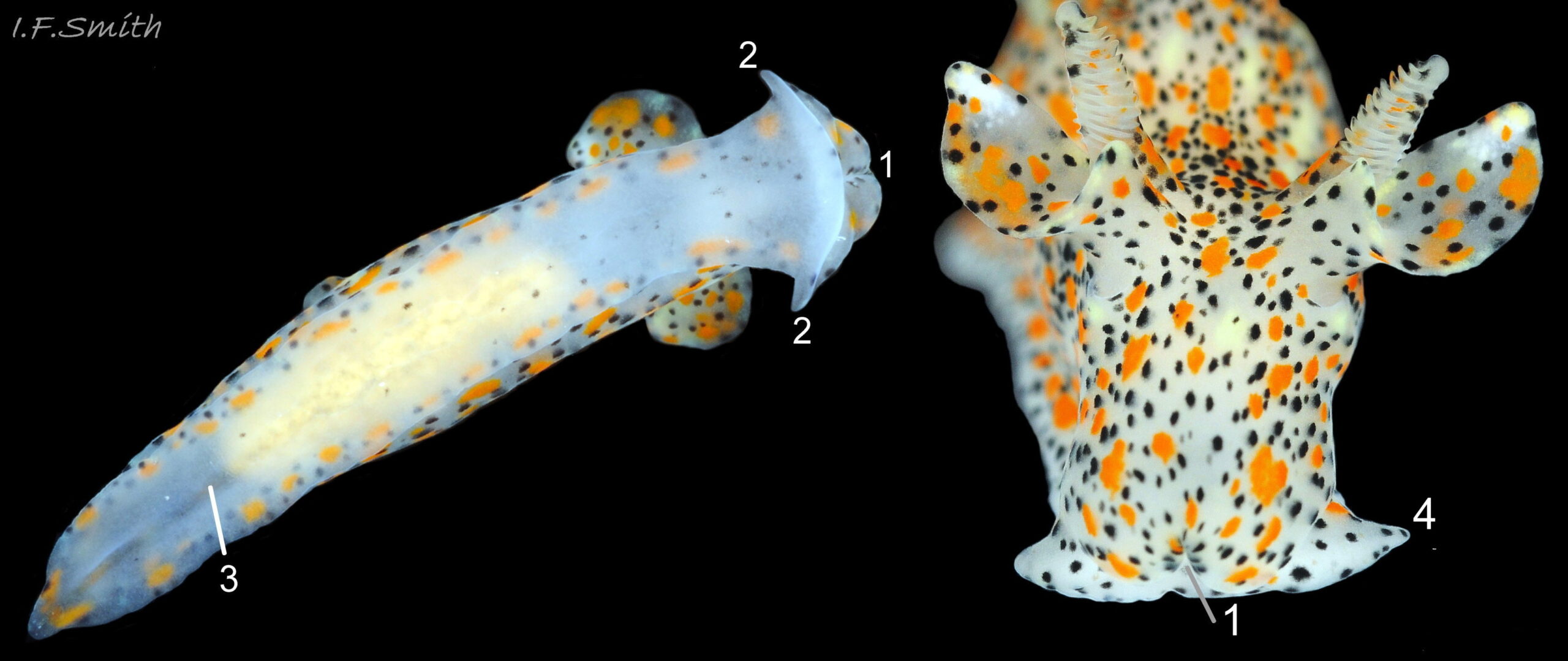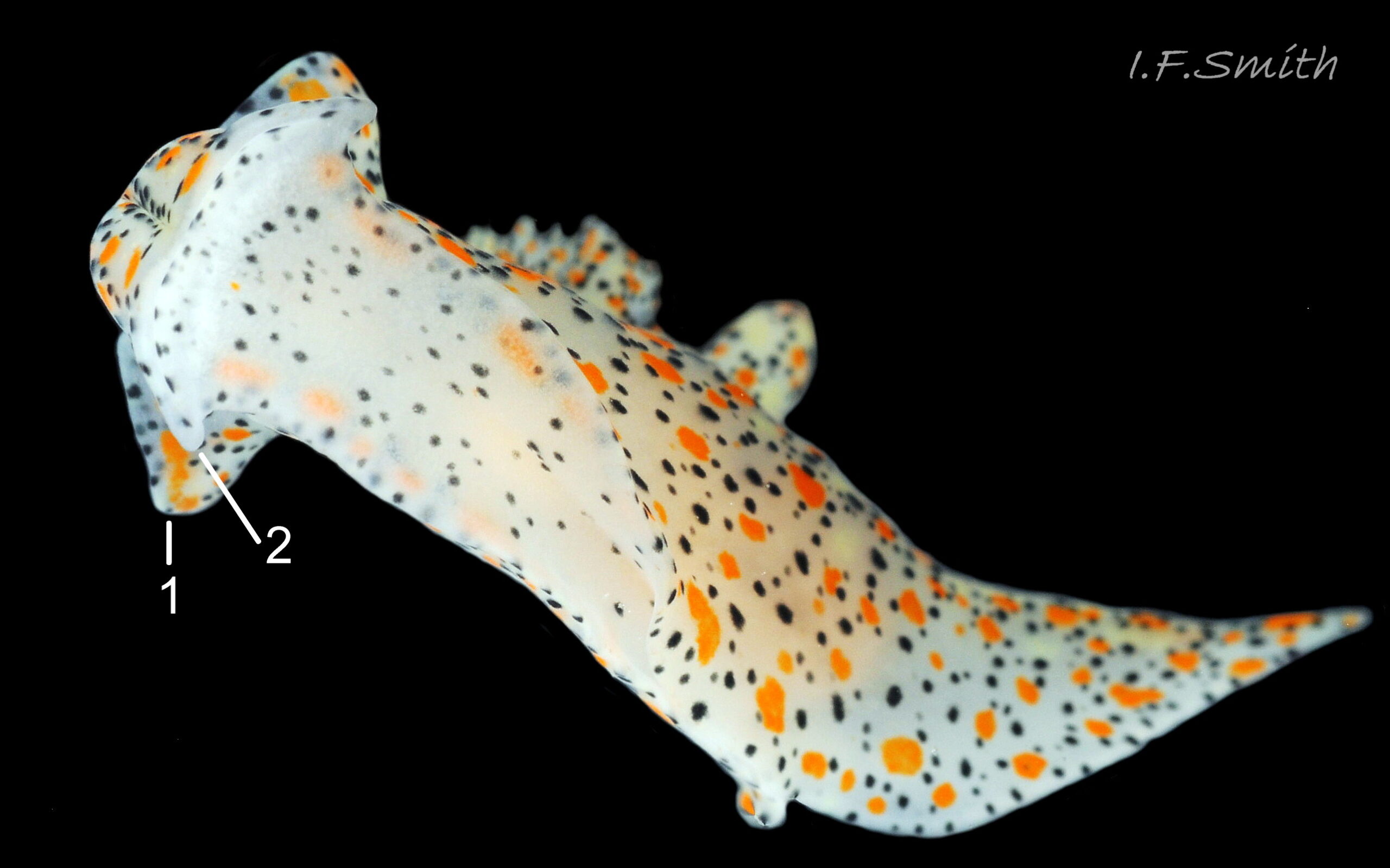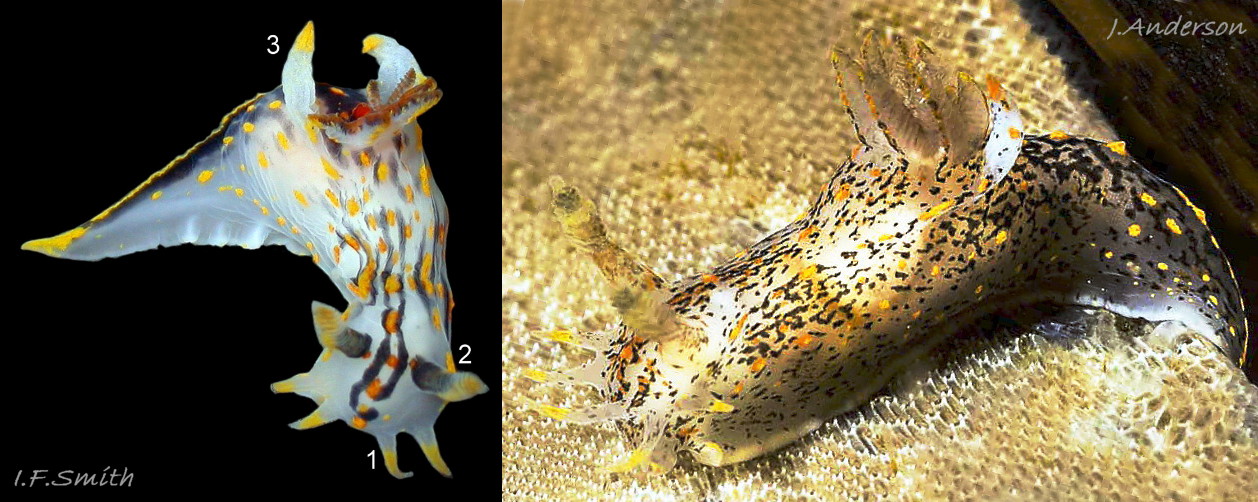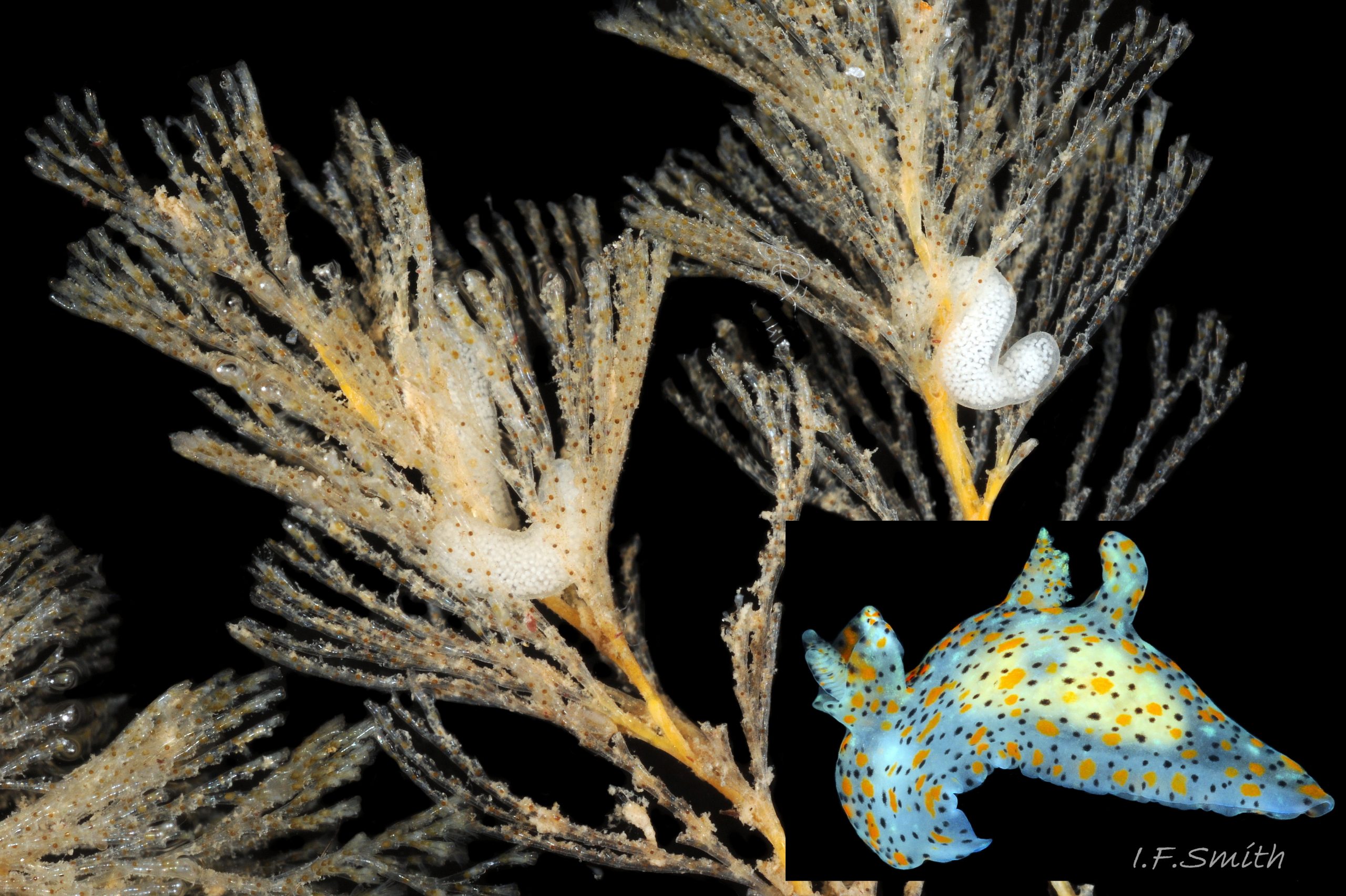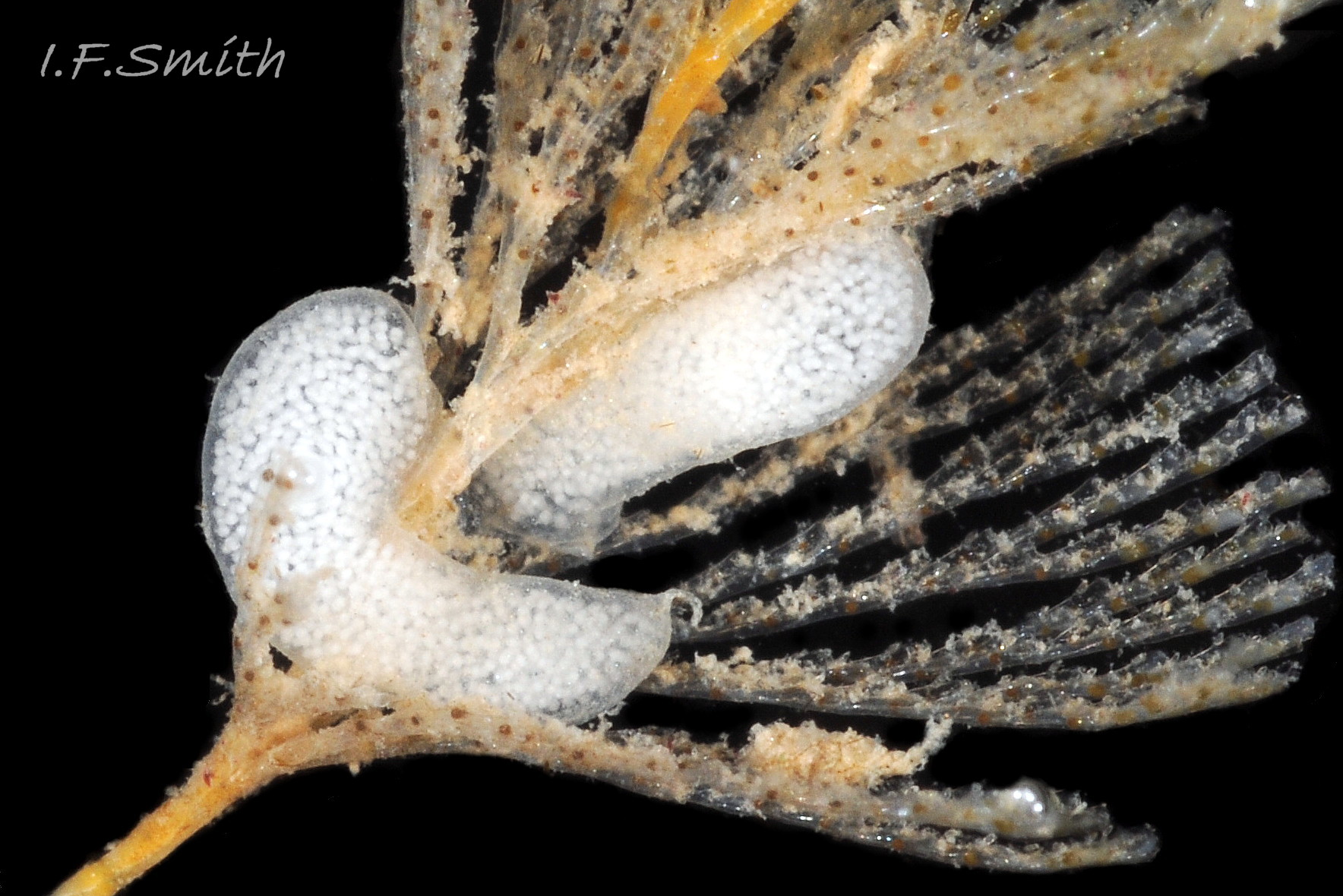Click image to enlarge with full caption. Main text below slider.
Thecacera pennigera (Montagu, 1813)
Synonyms: Thecacera maculata Eliot, 1905 ; Thecacera lamellata Barnard, 1933.
Current taxonomy: World Register of Marine Species (WoRMS)
http://www.marinespecies.org/aphia.php?p=taxdetails&id=140840
GLOSSARY below.
Body description
T. pennigera grows up to 30 mm long. When extended, it is long and slender with a truncated anterior, and it tapers to a pointed posterior 01 Thecacera pennigera . The body is smooth and translucent white often revealing central pale-buff viscera 02 Thecacera pennigera . There are no ridges representing the vestigial edge of the mantle such as on Polycera spp. The body and all appendages are covered in well defined orange and black pigment marks and less-well defined opaque whitish marks. The pigment marks are more numerous and, relative to body size, smaller on large specimens 03 Thecacera pennigera .The penis/common genital opening is behind the right rhinophore 04 Thecacera pennigera , 05 Thecacera pennigera & 06 Thecacera pennigera .
The rhinophores have a smooth basal third, and the upper two thirds have up to 14 prominent lamellae including incomplete ones 07 Thecacera pennigera . They are translucent-white with pigment marks like the body. They are enclosed for almost their full height on all sides, except the mesial side, by a flared sheath with a projecting collar-like summit 08 Thecacera pennigera.
Three or five, bipinnate or tripinnate gills 09 Thecacera pennigera arise from a common base in front of the anus near the centre of the notum 10 Thecacera pennigera. The pinnae are protected by the distally facing, orange and black blotched, stout main shafts of the gills 11 Thecacera pennigera . The gills are arranged in a ‘U’ open to the posterior where they are shielded by a pair of large, erect, club-like, glandular lobes. The lobes are coloured like the body and have a large, internally opaque-white tip 10 Thecacera pennigera. They are sometimes deformed 12 Thecacera pennigera .
Viewed dorsally, the anterior of the head is rectangular 13 Thecacera pennigera, sometimes with a slight medial notch 08 Thecacera pennigera leading to the mouth 14 Thecacera pennigera. There are no oral tentacles or oral veil with elongate processes, but the head expands on each side into a wide lateral flap to conceal the white propodial tentacles 15 Thecacera pennigera .
The narrow sole is translucent white with variable numbers of opaque black spots 15 Thecacera pennigera . When extended, it is of uniform width for most of its length, tapering gently to a point at the posterior and extending at the convex anterior into distinct propodial tentacles 14 Thecacera pennigera . There is a distinct, wide median groove on the posterior part of the sole, and some dorsal markings are visible through it, especially laterally. The foot is narrow and only visible dorsally as a narrow fringe coloured as the rest of the body 01 Thecacera pennigera .
Key identification features
Thecacera pennigera
1) In Atlantic, body has numerous orange and smaller black marks. In Pacific, marks often fewer and larger.
2) No oral veil with elongate processes 12 Thecacera pennigera .
3) Each rhinophore enclosed on three sides by clubbed sheath, mesially open, almost as high as rhinophore, and with orange and black marks 08 Thecacera pennigera.
4) Single large, translucent white, erect, elongate process on either side of gills, with internal opaque white in tip, and with orange and black marks on surface 10 Thecacera pennigera.
Similar species
Polycera quadrilineata (Müller, 1776) and Polycera norvegica (Sørensen, Rauch, Pola & Malaquias, 2020) 16 Thecacera pennigera
1) Occasionally, have black and orange marks on body.
2) Oral veil with four to six yellow elongate processes.
3) No sheath enclosing rhinophores.
4) Single large, translucent white, yellow-tipped, erect, elongate process on either side of gills.
Habits and ecology
T. pennigera is mainly sublittoral and occasionally found at ELWS. It feeds on Bugula plumosa and probably other Bugula species. Its local abundance fluctuates greatly, probably because Bugula species are opportunist colonisers of bare surfaces, lasting until displaced by less ephemeral growths (Rudman, 2002). Dispersal is probably assisted by Bugula on ship hulls (Thompson & Brown, 1984). It breeds when under 12 mm length. It is a simultaneous hermaphrodite. The spawn mass is a short, flattened, white or fawn band wrapped around Bugula 17 Thecacera pennigera & 18 Thecacera pennigera or attached along one edge to the substrate from May to September in Britain. It is not known whether it hatches as planktonic, shelled, veliger larvae or as miniature crawling adults (Masterson, 2007).
The striking colour pattern is cryptic among the orange stems and orange-brown, spherical, resting-stage of zooids of Bugula 17 Thecacera pennigera . The glandular lobes by the gills distract attack from them, and they probably secrete a repugnatory substance. The thickened white collar of the rhinophore sheath may do likewise 12 Thecacera pennigera .
Distribution and status
T. pennigera is reputed to be a cosmopolitan species, first discovered in England, probably originating in the Pacific where both small and large mark forms occur (Rudman, 1998) GBIF map http://www.gbif.org/species/2291814 and iNaturalist map with images https://www.inaturalist.org/observations?taxon_id=51001 . Molecular sequencing may yet show its geographical forms to be several species. In Europe it occurs from western Ireland and the Netherlands into the Mediterranean. In Britain, it has been found on western and southern coasts from Suffolk to Anglesey and in the Isle of Man U.K. map NBN https://species.nbnatlas.org/species/NHMSYS0021056263 .
Acknowledgement
I thank Jim Anderson for use of his image of Polycera norvegica.
References and links
Alder, J. & Hancock, A. 1845-1855. A monograph of the British nudibranchiate mollusca. London, Ray Society.
Masterson, J. 2007. Report on Thecacera pennigera. Smithsonian Marine Station at Fort Pierce, U.S.A. http://www.sms.si.edu/irlspec/Thecacera_pennigera.htm
Rudman, W.B. 1997-2008. Sea Slug Forum http://www.seaslugforum.net/find/thecpen
Thompson, T.E. & Brown, G.H. 1984. Biology of opisthobranch molluscs 2. London, Ray Society.
Glossary
bipinnate = (of gill plume) twofold branching; boughs and branches, but no subsequent twigs; in one plane like a feather.
distal = away from centre of body or from point of attachment.
ELWS = extreme low water spring tide (usually near March and September equinoxes).
hermaphrodite, simultaneous = individual acts as both male and female at the same time with similar partner(s).
lamellae = (of sea slugs) small plates on rhinophores or leaflets of gill.
mantle = (of nudibranchs) sheet of tissue forming part or all of notum.
mesial = (adj.) on or facing towards the midline of the body.
notum = dorsal surface of the animal.
pinna = (pl. pinnae) primary element/leaflet of a pinnate gill, leaf, feather etc.
plankton = animals and plants that drift in pelagic zone (main body of water).
propodial tentacles = tentacular, lateral extensions on anterior of the foot.
rhinophore = chemo-receptor tentacle; many sea slugs have a pair on top of the head.
tripinnate = (of gill plume) threefold branching; “boughs, branches, twigs” in one plane like a feather.
veliger = shelled larva of marine gastropod or bivalve mollusc which swims by beating cilia of a velum (bilobed flap).
